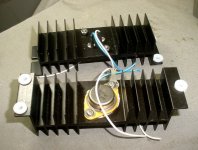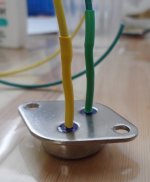Is it not just ordinary insulated wire with sleeving slipped over one end (I use silicone sleeving for that kind of thing).
A data sheet for the MJ21194 and BUZ900 FET says 1mm lead diameter so it could well be standard at that.
Yes it's insulated wire, but (I think) it has a jump hole so you plug the wire directly into the pin. I have found similar type of connectors such as this:
An externally hosted image should be here but it was not working when we last tested it.
But I was looking for thicker wires and one with a larger diameter hole (this one doesnt fit TO-3 pins.
You can crimp female Molex pins or other brand equivalents onto the end of your wires, and then push them onto the male pins. Sleeve them with heat shrink or other tubing if you wish. There are single pin plastic Molex housings, which you could also use, though to me, that seems more than is needed.
TO-3 Lead size is 0.036” to 0.043” (0.97 to 1.09mm)
Transistor Case Packages, TO-3 Style Flange Mount Case
Transistor Case Packages, TO-3 Style Flange Mount Case
If you can concede to wrap wires around the TO-3 pins, solder, and sleeve, well, that's a better connection than any set of contacts, and not that difficult to change if you blow a device (shouldn't happen all that often, after all).
I just recently finished a project where I socketed TO-3 devices for rectifier and capacitance multiplier duty. I used good quality sockets, but the base and emitter lugs were pretty fragile (yes, I busted one - what a pain). One of the plastic TO-3 positioner frames and wrapped connections like the ones I just described probably would have been more rugged/suitable.
I just recently finished a project where I socketed TO-3 devices for rectifier and capacitance multiplier duty. I used good quality sockets, but the base and emitter lugs were pretty fragile (yes, I busted one - what a pain). One of the plastic TO-3 positioner frames and wrapped connections like the ones I just described probably would have been more rugged/suitable.
As a struck of luck, there is never any problem that theese leads are to carry as much as 30Amps continuisly. If one use a lead similar to 1,5mm², one would never have any problem with either influence of the resistance in the lead or experiencing the lead to burn off due to over-current drawn through it.
- Status
- This old topic is closed. If you want to reopen this topic, contact a moderator using the "Report Post" button.
- Home
- Amplifiers
- Solid State
- Lead size of TO-3 package and where to get insulated jumper wires?

